Abstract
COVID-19 pandemic has impacted all walks of life. In education sector, all the teaching and learning process was shifted into online or virtual learning approach. Several studies have reported that virtual learning causes the increase of stress level among students. A study was conducted among UNITEN students in Special Semester 2020/2021 to find the impact on virtual learning to their studies and mental health. An online survey was distributed among all active UNITEN students in that semester. From 274 responses obtained, 53% indicated that they are able to cope with the changes in teaching and learning due to COVID-19. Slightly more than half (55%) indicated that their stress increased during this period. It is observed that more female students reported increase in stress level, compared to male students. Among the factors that contribute to the increase in stress level are being unable to discuss face-to-face with classmates, having non-conducive learning environment at home, and having difficulty to perform in online examination.
Keywords: COVID-19, virtual learning, stress, mental health
Introduction
The COVID-19 pandemic has impacted on how the world works since 2020. In education sector, the conventional approach on teaching and learning such as having physical face-to-face classes and examinations cannot be carried out as lockdown was imposed to limit the spread of COVID-19 virus (Abumalloh et al., 2021; Marghescu et al., 2021; Mouratidis & Papagiannakis, 2021).
In Malaysia, the Movement Control Order (MCO) implemented in March 2020 has forced educational institutions, including Universiti Tenaga Nasioal (UNITEN), to shift the teaching and learning to virtual learning (VL) or online learning.
Various challenges faced by the academic institution, the academics as well as the students due to the changes in teaching and learning. Among the top challenges or difficulties faced by the students are internet connect issue or limited connection (Nassr et al., 2020), limited interaction between lecturer and student, and among students (Wijanto et al., 2021) and non-conducive home learning environment (Li & Che, 2022)
These difficulties may lead to effect the well-being of the students such as increase in stress level, anxiety and depression. Recent studies have reported that COVID-19 pandemic has increased the stress level among college and university students (Wang et al., 2020, Son et al., 2020). Increase of stress level is one of the factors that could lead to poor mental health. It was indicated that situation regarding Malaysian students’ mental health is challenging, that is made worse by the negative attitudes of students towards mental health issues. Approximately 30% of Malaysians, aged 16 years or older are reported to have mental health issues (Hassan et al., 2018).
This paper describes the study done to investigate the effect of VL among students at Universiti Tenaga Nasional (UNITEN). The main objective of this study is to find out whether learning in virtual mode has increased the academic stress level among students at UNITEN. This study also aimed to determine the factors that would lead to the increase of stress level.
An online survey was distributed to the active students in May 2021, which was during Special Semester 2020/2021. In this semester, all courses were conducted in virtual learning mode. All assessments were also conducted in online mode or using alternative assessment approach.
The results from this paper will provide some insight on how VL has impacted the students’ stress level and highlight some of the factors that leads to the increase of stress level.
Method
A set of questions was developed to form the questionnaire for the survey. It is divided into three parts. The first part (A) consists of questions about respondents’ background including the gender, college and level or year of study. In the second part (B), the students are asked to give rating on the questions given based on their learning experience during the semester. There are four questions in this part where the student would rate using 5-level Likert scale, as shown in Table 1. The third part (C) consists of questions asking the impact of VL on the students’ mental health, particularly their stress level, and the factors contributed to the increase of stress level, if any.
The questionnaire was developed and deployed using Microsoft Form, an online platform that typically used to conduct survey and also simple quizzes. An email was sent to all active students in Special Semester 2019/2020 inviting them to participate in the survey voluntarily. The survey was opened towards the end of the semester for two weeks. The survey was conducted anonymously, where there is no information that is identifying the student is required.
The data was collected after the survey closed and analysed using Microsoft Excel. In the analysis, median and frequency of distribution analysis are used as it is more suitable for ordinal scale data used in this survey (Mcleod, 2019).
Result and Discussion
The survey received a total of 274 responses among UNITEN students. As the survey was conducted during the special semester, some of the students are undergoing their industrial training, while some students were not taking any class (188 taking class, 53 industrial training, 33 not taking any class). In the survey, branching approach were used. Part A and Part C need to be answered by all respondents. Part B only need to be answered by students taking class during special semester. If the respondent indicated that he/she was undergoing industrial training or not taking any class, Part B will be skipped.
The background (Part A)
In Part A, the questions include gender, age and level of study. Table 2 shows the breakdown of the number of respondents based on gender. The number of male and female respondents are almost the same (male = 140, and female = 134).
At UNITEN, there are five colleges – College of Computing and Informatics (CCI), College of and Social Studies (CES), College of Business and Accounting (COBA), College of Engineering (COE) and College of Graduate Studies (COGS). The breakdown of responses based on college are shown in Table 3.
Table 4 shows the breakdown of the responses based on level and year of study. Majority of the responses are from bachelor degree students (67.2%) followed by diploma students (12%) and postgraduate students (11.7%).
Virtual learning experience (Part B)
There are 188 responses obtained for Part B, as this part were answered by only students taking class in special semester. Table 5 shows the summary of analysis result for all four Part B questions. The median and mode for all four questions is 4 (agree).
Based on the responses obtained for question B1 (I am satisfied with virtual learning this semester), majority of the students are either agree (47.9%) or strongly agree (18.1%) with the statement. Another 26.1% neither agree nor disagree while the remaining 8% either disagree or strongly disagree as illustrated in Figure 1. This indicates that generally most of the students are satisfied with their virtual learning experience in special semester. However, when the responses are grouped based on gender, more male students are satisfied compared to female students.
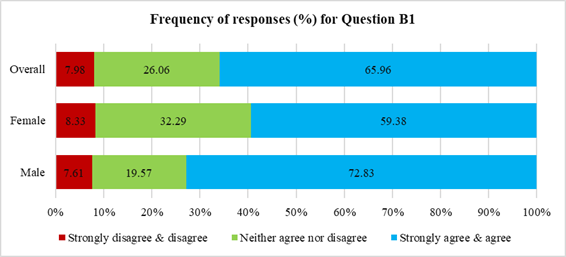
For question B2 (), both the median and mode is 4 (agree). However, looking at the frequency distribution, there is a significant number of respondents (32.98%) answered neither agree nor disagree, indicating that these students are uncertain with their ability to cope with the changes. There are more female students (16.67%) who are unable to cope with the changes in teaching and learning comparing to male students (10.87%), as illustrated in Figure 2.
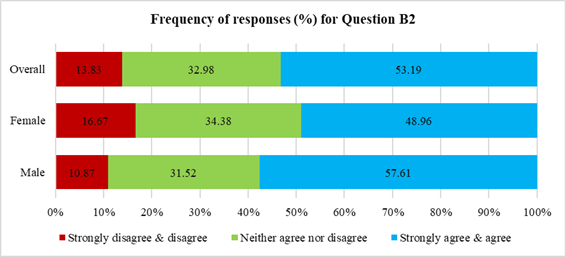
For question B3 (), both the median and mode is also 4 (agree). Figure 3 illustrate the frequency of responses for B3, showing that most student agree that their lecturers conduct the VL session well.
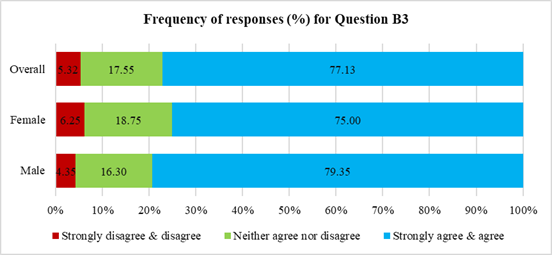
Figure 4 illustrate the frequency of responses for question B4 (The resources made available in Brighten/Moodle are enough to help me to learn).
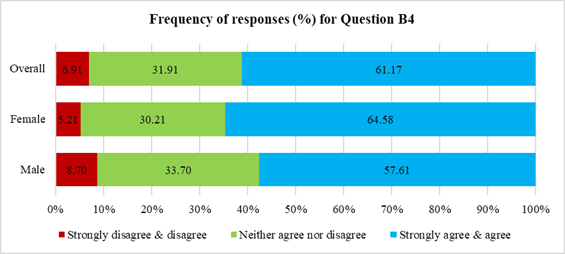
Impact of VL on stress level (Part C)
In Part C, the students were asked whether their stress level was increased due to virtual learning (VL) during the pandemic. As illustrated in Figure 5, more than half of the responses (55%) indicated that their stress level increases, 39% indicated their stress level remains the same while the remaining 6% indicated that their stress level decreases. More female students indicated that their stress level increases (62.69%) comparing to male students (47.86%).
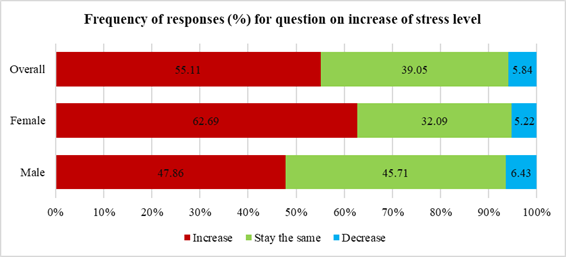
It is also observed that there are a small percentage of students (5.84%) indicating decrease in stress level. Among reasons cited for this decrease are easier or more comfortable to study at home, does not need to travel to campus to attend classes, and having adapted well with the virtual learning method.
In this part also, the students are asked to rate the given seven factors, whether they are contributing to the increase of stress level. The seven factors are:
- Unable to discuss face-to-face with classmates
- Unable to communicate face-to-face with lecturer
- Non conducive learning environment at home
- Difficult to perform in online test/examination
- Problem with internet connection/data limitation
- Difficulty in using online tools and system
- Difficulty to understand when learning online
Figure 6 illustrates the summary of frequency of responses for each of the factors, with the rating from ‘none’, ‘low’, ‘medium’, ‘high’, to ‘very high’. ‘None’ would mean that the particular factor does not contribute to the increase of stress, while ‘very high’ would mean that factor contributes very significantly to the increase of stress for the student. For this part, the focus of the analysis is on the rating of ‘high’ and ‘very high’.
Factor number one is the highest in causing the increase in stress, where 28.1% indicated that it caused very high stress and another 23.7% indicated it causing high stress. The second highest factor causing stress is factor number 2 (22.3% - very high stress, and 21.9% - high stress).
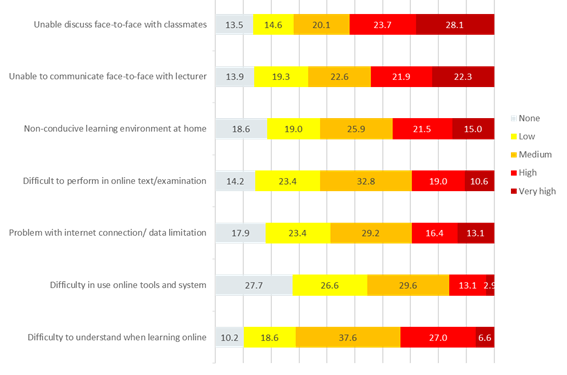
The third highest factor contributing to the increase in stress is related to non-conducive learning environment at home. More than 36% of the respondents rated that this factor is either ‘high’ or ‘very high’ in causing the increase in stress level. The next factor is related to the difficulty in understanding the material when learning online, which more 33.6% of the respondents rated it as either ‘high’ or ‘very high’. From this, we could say that for one-third of the respondents, the home learning environment is less suitable and not conducive for them to learn, and this make it difficult for them to learn. Internet issues also caused the increase of stress level, as 29.5% rate it as high or very high.
Based on the responses, it can be said that the main cause for increase of stress level in virtual learning is due to not being able to meet up physically with peers and lecturers. In virtual learning, the students are still able to meet up face-to-face via online platform, however, it seems that physical interaction is be very important for them as part of the teaching and learning process.
Most of the students have gone through virtual learning approach for two semesters. Many of them are already familiar with the online tools and systems used in VL. However, there is still a relatively significant percentage of students having problem with internet connection or facing data limitation causing increased stress in VL.
Conclusions
COVID-19 pandemic has altered the landscape of education significantly. During the pandemic, all the teaching and learning activities were converted into alternative approaches mainly through online or virtual learning. One of the impacts on student is on the increase of stress level, which can be observed after going through VL for a couple of semesters. This study reveals that VL has indeed impacted the stress level among students. The top factors that contributed to the increase of stress level are the lack of physical interaction between the students and also with the lecturers.
One of the main limitations of this study is that the survey was carried out during special semester where there was less number of students taking class. The number of respondents was also not spread well among the different colleges. Nevertheless, the feedback obtained via this survey does give a general picture of the difficulty faced by the students in VL. Moving forward on hybrid learning or gradually going back to physical class in the post-pandemic era is expected to mitigate the increase of stress level due to VL.
Acknowledgments
The authors wish to thank UNITEN for supporting and funding this research through BOLD research grant 2/2021/2021163. The authors also would like to thank all who has directly or indirectly providing assistance for this project.
References
Abumalloh, R. A., Asadi, S., Nilashi, M., Minaei-Bidgoli, B., Nayer, F. K., Samad, S., Mohd, S., & Ibrahim, O. (2021). The impact of coronavirus pandemic (COVID-19) on education: The role of virtual and remote laboratories in education. Technology in Society, 67, 101728. DOI:
Hassan, M. F., Hassan, N. M., Kassim, E. S., & Hamzah, M. I. (2018). Issues and challenges of mental health in Malaysia. International Journal of Academic Research in Business and Social Sciences, 8(12), 1685–1696. DOI:
Li, J., & Che, W. (2022). Challenges and coping strategies of online learning for college students in the context of COVID-19: A survey of Chinese universities. Sustainable Cities and Society, 83, 103958. DOI:
Marghescu, C., Drumea, A., Pantazică, M., & Codreanu, N. (2021). COVID-19: the Shift to E-learning - Student’s Perception and Outlooks. 2021 IEEE 27th International Symposium for Design and Technology in Electronic Packaging (SIITME), 313-316. DOI:
McLeod, S. A. (2019, August 03). Likert scale. Simply Psychology. www.simplypsychology.org/likert-scale.html
Mouratidis, K., & Papagiannakis, A. (2021). COVID-19, internet, and mobility: The rise of telework, telehealth, e-learning, and e-shopping. Sustainable cities and society, 74. DOI:
Nassr, R. M., Aborujilah, A., Aldossary, D. A., & Aldossary, A. A. A. (2020). Understanding Education Difficulty During COVID-19 Lockdown: Reports on Malaysian University Students’ Experience. IEEE Access, 8, 186939-186950. DOI:
Son, C., Hegde, S., Smith, A., Wang, X., & Sasangohar, F. (2020). Effects of COVID-19 on College Students’ Mental Health in the United States: Interview Survey Study. Journal of Medical Internet Research, 22(9), e21279. DOI:
Wang, X., Hegde, S., Son, C., Keller, B., Smith, A., & Sasangohar, F. (2020). Investigating Mental Health of US College Students During the COVID-19 Pandemic: Cross-Sectional Survey Study. Journal of Medical Internet Research, 22(9), e22817. DOI:
Wijanto, M. C., Karnalim, O., Ayub, M., Toba, H., & Tan, R. (2021). Transitioning from Offline to Online Learning: Issues from Computing Student Perspective. 2021 IEEE Global Engineering Education Conference (EDUCON), 1137-1142. DOI:
Copyright information

This work is licensed under a Creative Commons Attribution-NonCommercial-NoDerivatives 4.0 International License.
About this article
Publication Date
18 August 2023
Article Doi
eBook ISBN
978-1-80296-963-4
Publisher
European Publisher
Volume
1
Print ISBN (optional)
-
Edition Number
1st Edition
Pages
1-1050
Subjects
Multi-disciplinary, Accounting, Finance, Economics, Business Management, Marketing, Entrepreneurship, Social Studies
Cite this article as:
Anuar, A., Ibrahim, Z., Jamaluddin, J. E., & Hari, Z. (2023). Virtual Learning During The Covid-19 Pandemic And Student Stress. In A. H. Jaaffar, S. Buniamin, N. R. A. Rahman, N. S. Othman, N. Mohammad, S. Kasavan, N. E. A. B. Mohamad, Z. M. Saad, F. A. Ghani, & N. I. N. Redzuan (Eds.), Accelerating Transformation towards Sustainable and Resilient Business: Lessons Learned from the COVID-19 Crisis, vol 1. European Proceedings of Finance and Economics (pp. 896-904). European Publisher. https://doi.org/10.15405/epfe.23081.82

